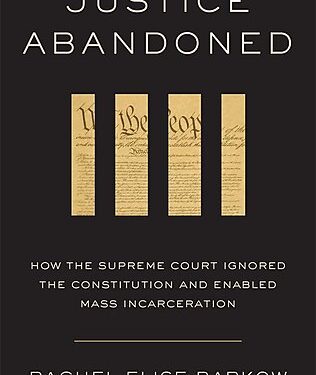NYU Law Professor Rachel Barkow has written an extraordinary new book, Justice Abandoned: How the Supreme Court Ignored the Constitution and Enabled Mass Incarceration. It is a damning indictment of our judicial system’s complicity in the dramatic expansion of incarceration over the past several decades. Judge-made changes in the law have created a new status quo: The United States—with five percent of the world’s population—now contains 25 percent of its prisoners.
Barkow’s central thesis is that the Supreme Court has failed to execute its core function: to safeguard individual liberties against the encroaching power of the state. Even worse, it has cloaked this failure in the guise of public safety. As Barkow explains, the Court has refused to “police the police.” When supervision of government fails, egregious abuses of authority go unchecked. The Court’s failure to enforce constitutional guarantees has enabled mass incarceration to metastasize.
In Justice Abandoned, Barkow explains the world that the Court has helped to create through stark examples and vivid illustrations: a world in which government powers expand and individual rights erode.
Observers of our criminal justice system are all too familiar with the ways in which the deck is stacked against criminal defendants. As a former public defender, I quickly learned that once a judge began his ruling by praising my advocacy, I was about to lose. Indeed, it does not take long for criminal defense attorneys to realize that their clients often lose even when the law is on their side. This illuminates a systemic problem: On the ground, courts do not always take constitutional rights seriously. The hope that appellate courts might rectify such injustices often proves futile when the Supreme Court itself has decided to weaken those rights’ foundations.
Barkow rests her analysis on six pivotal Supreme Court decisions. She provides powerful and painstaking arguments that demonstrate how, in each case, the Court has drifted from the Framers’ original understanding of the Constitution.
The backstory of this drift lies in the social turmoil of the second half of the twentieth century. As Barkow explains, the Framers created an independent judiciary with life tenure—precisely because they wanted to insulate judges from transient political pressures. However, as crime rates rose, the War on Drugs intensified, and racial tensions simmered, the Court appeared increasingly wary of the possibility of public backlash against previous rulings that were perceived as “soft on crime.” Among the consequences was a judicial retreat from constitutional principles to mollify critics.
Justice Abandoned offers more than discussions of abstract legal principles. Barkow is a gifted storyteller who provides accounts of the law’s effects on real people. The case of Tyrone Tomlin serves as a chilling example of how easily an individual can be swept into the machinery of the criminal justice system—even in the absence of any real wrongdoing. Tomlin’s three-week detention at New York City’s notoriously violent Rikers Island, based on a false allegation of drug residue on a straw, highlights the devastating consequences of unchecked police action and a system in which bail serves as pretrial punishment. The brutal assault Tomlin endured while incarcerated underscores the human cost of a system that gives little weight to due process and the presumption of innocence.
Similarly, the case of Clarence Aaron, a collegiate athlete who overcame significant adversity only to receive a life sentence for his peripheral involvement in a drug conspiracy, exposes the harsh realities of mandatory minimum sentencing and the immense pressure to plead guilty. What was the government’s justification for Aaron’s draconian sentence? The prosecutor’s answer: Aaron’s arrogance in exercising his constitutional right to a trial by jury. This remarkable explanation reveals a system in which the very act of asserting one’s rights can be penalized more severely than the underlying criminal conduct of others.
The injustices faced by Tomlin and Aaron are the direct result of a Court that has valued political expediency more than the protection of the rights of the accused. In Justice Abandoned, Barkow artfully describes the four most important cases that have amplified the dysfunction and cruelty of our criminal justice system.
Terry v. Ohio (1968) weakened centuries-old protections against unreasonable searches and seizures. Like much of the rest of the Bill of Rights, the Fourth Amendment—born out of the Framers’ aversion to British writs of assistance—was designed to protect the people against the arbitrary exercise of governmental power. The Court had previously faced undeserved criticism for a series of recent pro-defendant rulings; it responded by creating a new, lower standard of “reasonable suspicion” for brief investigatory stops and frisks. Terry afforded police significant deference in such encounters; that opinion marked a steep departure from the Fourth Amendment’s original understanding.
United States v. Salerno (1987) triggered an equally radical change to our criminal justice system: It flipped the presumption of pretrial release to a presumption of pretrial detention. Barkow explains that the Framers envisioned pretrial detention as a limited measure that would only be used to ensure appearance at trial. After Salerno, all that is required to deprive a defendant of liberty is for a prosecutor to assert that the defendant is dangerous. The result: 75 percent of federal defendants are now detained before trial.
Salerno provided prosecutors with a second powerful tool to induce guilty pleas: it offered immediate release in exchange for a guilty plea while simultaneously providing for pretrial detention based on the very same underlying allegations. The promise of immediate freedom can provide an almost irresistible incentive to plead guilty—even for the innocent.
Bordenkircher v. Hayes (1978) came about because of the terrible plight Paul Lewis Hayes faced. Hayes was threatened with a life sentence under Kentucky’s Habitual Criminal Act after refusing to accept a five-year plea deal on a forgery charge. His case found its way to the Supreme Court, which unabashedly embraced coercive plea bargaining, which authorizes prosecutors to use the threat of harsher penalties as leverage in plea negotiations. The Court’s opinion acknowledged the coercive potential of that tactic, but ultimately deemed it to be an inherent and permissible aspect of plea-bargaining.
As Barkow argues, this decision helped displace the Framers’ vision of the jury trial: They saw it as the constitutionally prescribed mechanism by which we adjudicate criminal cases. In effect, the Court’s opinion supplanted the jury trial with a system of plea-driven mass adjudication. The Framers intended to make stripping Americans of their liberty difficult and costly. Bordenkircher made it easy and cheap.
Harmelin v. Michigan (1991) underscores what happens once a defendant formally enters the system by way of criminal conviction or guilty plea. In Harmelin, the Court neutered much of the Eighth Amendment’s prohibition against cruel and unusual punishment: That opinion held that no sentence could be deemed inherently disproportionate to the crime, regardless of its triviality. The case of Jerry DeWayne Williams, who was sentenced to 25 years to life under California’s habitual offender law after he was convicted of stealing a slice of pizza, highlights how even minor offenses can lead to excessively prolonged periods of incarceration.
Barkow shows how these cases—along with Rhodes v. Chapman (1981), which largely foreclosed challenges to inhumane prison conditions, and McCleskey v. Kemp (1987), which made it exceedingly difficult to challenge racially disproportionate impact in sentencing—illuminate a Supreme Court that has systematically weakened constitutional safeguards in exchange for a flawed and counterproductive vision of public safety.
Barkow’s work reminds us that the Framers intended juries to serve as a bulwark against oppression. The Constitution’s text explicitly commands that “all” federal crimes must be tried by jury, and the Sixth Amendment underscores that command by repeating that “in all criminal prosecutions” the defendant has the right to a public trial by an impartial jury. Barkow argues that attending to this constitutional mandate would restore healthy norms to the criminal justice system.
Justice Abandoned is a meticulously researched and powerfully argued account of the detrimental consequences of modern Supreme Court criminal justice opinions and—not coincidentally—how antithetical those opinions are to the original understanding of the Constitution. However, it is impossible to provide a full accounting of the sheer breadth of the damage the Court has done to our criminal justice system in a single book. Given the reality of page constraints, I respect Barkow’s strategic decision to limit her assessment to six cases. Absent such limitations, I would suggest a seventh case.
The consequences of Whren v. United States (1996) have been so catastrophic that they deserve more extensive attention. When I was a public defender, I observed that many of my clients would enter the criminal justice system through what are commonly referred to as “Whren stops.” This stems from the Court’s 1996 holding in Whren, which gave police the power to make pretextual traffic stops, based on dubious rationales like a busted taillight or cracked windshield. When pretextual stops become commonplace, they inevitably lend support to allegations of racial profiling in traffic stops—also known as the criminalization of “driving while black.”
Whren has been widely criticized for its potential to facilitate discriminatory policing practices. The opinion authorizes police to go on fishing expeditions, particularly against minority drivers. Like Terry, Whren opened the floodgates to abuses of authority by law enforcement. Whren stops are often initiated for trivial reasons and can rapidly escalate into searches and arrests; such incidents disproportionately funnel residents of minority communities into the criminal justice system.
In short, Whren is something like a silent partner to Barkow’s list of marquee opinions. When joined to such cases as United States v. Salerno, which allows for preventive detention, Bordenkircher v. Hayes, which legitimizes coercive plea bargaining, and Harmelin v. Michigan, which limits proportionality in sentencing, the result is a legal framework that facilitates entry into the system and entanglement within it. In my view, Whren v. United States is an evocative symbol of the way that initially innocuous legal doctrines can have terrible consequences on both the lives of countless individuals and the integrity of our constitutional principles.
Barkow’s insightful work is a masterful account of judicial cause and incarcerative effect. She concludes by noting that strict adherence to originalism, the prevailing judicial philosophy of the current Court, would stem the tide and yield more just outcomes. Originalism generally has two main approaches: Original Intent, which focuses on the Framers’ specific intent, and the more widely accepted Original Public Meaning, which considers how the text was generally understood by the public at the time it was adopted.
However, a crucial flaw, Barkow observes, is that true originalist judges wouldn’t predetermine a conclusion and then contrive doctrines that erode constitutional safeguards to achieve their desired outcome. Yet this is precisely what self-proclaimed originalists on today’s Court frequently do, particularly when the rights of criminal defendants clash with state power and policing prerogatives. We would all be better off if the originalist majority on the Court would heed Barkow’s wise counsel.














